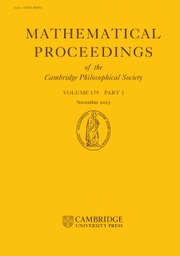No CrossRef data available.
Article contents
On congruence subgroups generated by two parabolic rational matrices
Published online by Cambridge University Press: 08 August 2025
Abstract
We study the freeness problem for multiplicative subgroups of  $\operatorname{SL}_2(\mathbb{Q})$. For
$\operatorname{SL}_2(\mathbb{Q})$. For  $q = r/p$ in
$q = r/p$ in  $\mathbb{Q} \cap (0,4)$, where p is prime and
$\mathbb{Q} \cap (0,4)$, where p is prime and  $\gcd(r,p)=1$, we initiate the study of the algebraic structure of the group
$\gcd(r,p)=1$, we initiate the study of the algebraic structure of the group  $\Delta_q$ generated by
$\Delta_q$ generated by  \[A = \begin{pmatrix}1 & 0 \\ 1 & 1\end{pmatrix} \text{ and } Q_q = \begin{pmatrix}1 & q \\ 0 & 1\end{pmatrix}.\]
\[A = \begin{pmatrix}1 & 0 \\ 1 & 1\end{pmatrix} \text{ and } Q_q = \begin{pmatrix}1 & q \\ 0 & 1\end{pmatrix}.\] $\Delta_{r/p} = \overline{\Gamma}_1^{(p)}(r)$, the congruence subgroup of
$\Delta_{r/p} = \overline{\Gamma}_1^{(p)}(r)$, the congruence subgroup of  $\operatorname{SL}_2(\mathbb{Z}[{1}/{p}])$ consisting of all matrices with upper right entry congruent to 0 mod r and diagonal entries congruent to 1 mod r. We prove this conjecture when
$\operatorname{SL}_2(\mathbb{Z}[{1}/{p}])$ consisting of all matrices with upper right entry congruent to 0 mod r and diagonal entries congruent to 1 mod r. We prove this conjecture when  $r \leq 4$ and for some cases when
$r \leq 4$ and for some cases when  $r = 5$. Furthermore, conditional on a strong form of Artin’s conjecture on primitive roots, we also prove the conjecture when
$r = 5$. Furthermore, conditional on a strong form of Artin’s conjecture on primitive roots, we also prove the conjecture when  $r \in \{ p-1, p+1, (p+1)/2 \}$. In all these cases, this gives information about the algebraic structure of
$r \in \{ p-1, p+1, (p+1)/2 \}$. In all these cases, this gives information about the algebraic structure of  $\Delta_{r/p}$: it is isomorphic to the fundamental group of a finite graph of virtually free groups, and has finite index
$\Delta_{r/p}$: it is isomorphic to the fundamental group of a finite graph of virtually free groups, and has finite index  $J_2(r)$ in
$J_2(r)$ in  $\operatorname{SL}_2(\mathbb{Z}[{1}/{p}])$, where
$\operatorname{SL}_2(\mathbb{Z}[{1}/{p}])$, where  $J_2(r)$ denotes the Jordan totient function.
$J_2(r)$ denotes the Jordan totient function.
MSC classification
Information
- Type
- Research Article
- Information
- Copyright
- © The Author(s), 2025. Published by Cambridge University Press on behalf of Cambridge Philosophical Society

